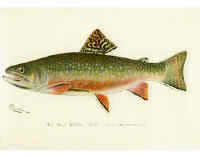 A re-post. We'll do the Western species later in the week -
A re-post. We'll do the Western species later in the week -
It's getting near Opening Day around here, so here's an update on the Salmonidae. For our other pieces on fishing, enter "fishing" in our search space - you will catch some good stuff - along with some random entries.
Taxonomy: The family Salmonidae includes a number of cool-water fish subfamilies: trout, salmon, char, grayling, Lake Whitefish, and other less well-known fish. The Brook Trout and Lake Trout are technically members of the Char subfamily of the Salmonidae.
Heritage: The aggressive, young-trout-killing Brown Trout is a transplant from Eurasia. The fast-water Rainbow Trout is a transplant from the Pacific watershed. The splendid Brook Trout and the big Lake Trout are the common native game species of the Eastern US, and both are technically Char, not trout per se. At this point, the wonderful game "trout" have been transplanted world-wide, and some have established viable wild populations, as with the trout in Patagonia, where you can even catch New England's Brook Trout today.
Anadromy: Most Salmonidae have the capacity, or the preference, to be anadromous - to migrate to salt water until maturity - when they have the opportunity. The Arctic Char, of culinary and cold water fame (anti-freeze in the blood), is anadromous. So is the Steelhead - actually a migratory Rainbow. Salmon are, of course. Sea-going fish grow larger on the rich variety of big-water foods. Interestingly, many land-locked Salmonidae imitate anadromy by entering streams to spawn, and then return to their home fresh-water lakes or just stay put in the streams, if there is enough to eat.
The Great Lakes and other large lakes have their own Salmonidae species, such as Lake Whitefish, and Lake Trout which are not found in trout streams.
Hatchery fish: When you fish for trout in the East, you are, in all likelihood, catching hatchery fish, not wild, born-in-nature fish. Too many anglers, and not enough habitat, so we pretend we are catching wild fish. Catch-and-release gives your fellow angler a chance, and saves your state government, or your fishing club, money on their hatchery budgets. Still, some wild breeding populations do exist, and fly-fishing with barbless hooks gives every fish a sporting chance to avoid the crushing humiliation of the sportman's net. But I still wonder what would happen if we banned all fresh-water stream fishing for five years. What would we find in our streams? Nothing? Or big, mature breeding trout hunkering under stream banks and fallen logs? We will never know, but I suspect that many of our streams would not support wild trout populations.
Other details:
- Superb taxonomy website: ITIS
- Good Eastern trout summary, Pennsylvania Fishes
- An example of how eastern states manage their fresh-water recreational fisheries, from Connecticut
- An example of what fish hatcheries do, from New York State
Image: Brook Trout, by Denton


 A re-post. We'll do the Western species later in the week -
A re-post. We'll do the Western species later in the week -
Fishes of the Week: Th...
Tracked: Nov 03, 02:06
Our guest author (don't know if he wants us to use his name) offers this summary as a companion piece to our summary of the Eastern Trout.Glaciers and mountain-building have created many distinct species of trout throughout the Pacific drainage. To find
Tracked: Jun 09, 06:05
That's your hard-working Editor in the background, fishing in April a couple of years ago. It's time to review some of our good trout posts from the past.For new readers, here's our first post on Fishing Bamboo.And here's a post about Hoagy Carmichael Jr.
Tracked: Mar 28, 19:01